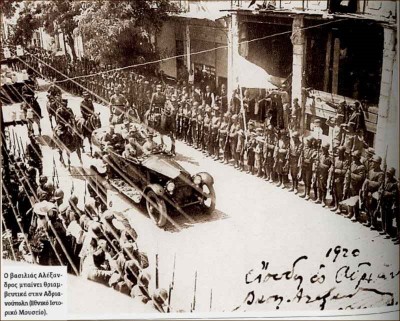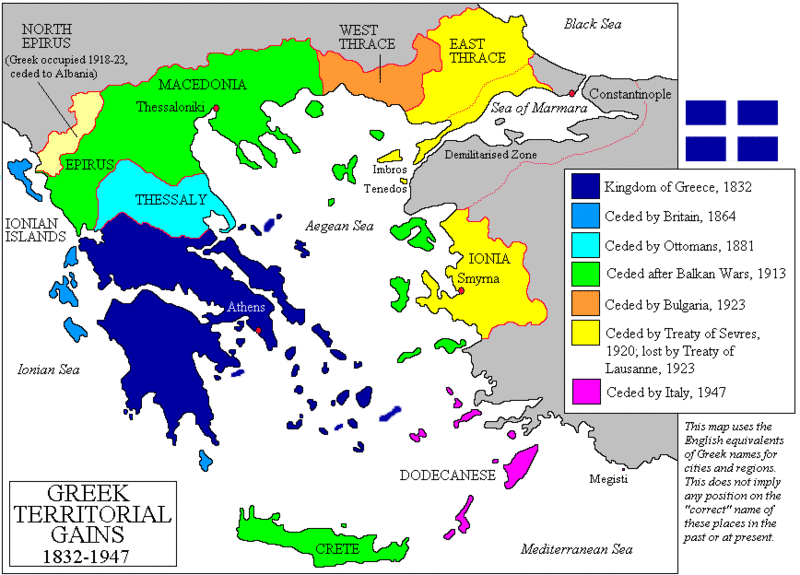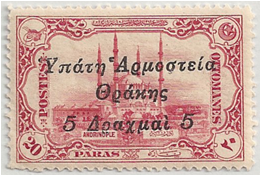ALBUM – View my Greek Occupation of Thrace album
Fast Facts
Region: Greece / Balkans Area
Group: Occupations in the Balkans
Classification: Military Occupation
Prior Regime: Inter Allied Occupation of Western Thrace
Key Dates:
1913 – 1919 – Thrace controlled by Bulgaria
1919, Oct 10 – Entente Forces officially take military control Western Thrace
1920, May 20 – Greece annexes Western Thrace
1920, Jul 12 – Greece moves into Eastern Thrace, setting up Adrianople as headquarters
1922, Aug 30 – Turkey defeats Greece at the Battle of Dumlupınar
1922, Aug-Oct – Turkish troops drive Greek troops out of the Turkish mainland and Eastern Thrace.
1923, Jul 24 – Lausanne Treaty signed establishing Greek / Turkish borders
Following Regime: Kingdom of Greece for Western Thrace, Republic of Turkey for Eastern Thrace
Scott Catalogue: (Thrace) N26-N84
Pick Catalogue: none
History

Toward the end of World War 1, in 1918, Entente forces defeated Bulgaria in Macedonia and as part of the surrender agreement, Bulgaria was forced to retreat from the area of Western Thrace, while “inter-allied” forces assumed control. On 10 Oct, 1919, General Charpy of France went to and assumed military control over the area. On 22 Oct, 1919, General Charpy was appointed Governor of Western Thrace, with headquarters in Komotini (Gumulcine). The subsequent Treaty of Neuilly agreed in November, Bulgaria ceded all of Western Thrace to the Entente, thereby cutting off Bulgaria’s direct outlet to the Aegean Sea.
After the war, the Allied Supreme Council (without the U.S.), gathered at a conference in San Remo in April, 1920. At that conference, it was agreed (among other things) that the Greeks would assume control of Western Thrace, and would be allowed a Greek presence in eastern Thrace as well as on the Anatolian west coast and the Aegean Islands commanding the Dardanelles. Upon this agreement Greek forces moved into Western Thrace to replace the international troops, and on 20 May, 1920, Greece officially annexed Western Thrace. This was quickly followed by the Treaty of Sèvres (10 August 1920) which essentially carved up the Ottoman Empire and the Anatolian region was never really accepted by all parties, but essentially gave Greece Eastern Thrace as well.
During this period, two major but related conflicts occurred. The Greco Turkish War (1919-1922) where Greece attempted to take as much land as possible including, Eastern Thrace, Eastern Anatolia and most of the islands in the Aegean. Simultaneously, the War of Turkish Independence (1919-1923) led by Mustafa Kemal Atatürk consolidated a Turkish nationalist movement and built a provisional army which eventually forced out occupational forces from Anatolia, overthrew the Ottoman Sultanate and established a modern secular state.
In Thrace, shortly after the annexation of Western Thrace, Greece moved quickly into Eastern Thrace. On 12 July, 1920, Greeks established their headquarters in Adrianople where the following day King Alexander I arrived in the city in a show of “victory”. After taking all of Thrace, they began their efforts in advancing into Ionia. With little support from its allies, Greece overextended its armies, and Turkey, with Soviet support, turned the tide of the war with a major with offensive launched on August 26, defeating the Greeks at the Battle of Dumlupınar near Afyon. Even today, 30 Aug, 1922, celebrated as the Victory Day and a national holiday in Turkey. Over the next couple of months, without support from Britain, France or Italy, Greece retreated from Anatolia and Eastern Thrace.
The war ended in late 1922, and a settlement at the Greco-Turkish Convention (20 Jan, 1923) allowed for the mutual exchange of populations where all Greeks resident in Turkey – except those in Constantinople and Eastern Thrace – were to be deported to Greece and, conversely, all Moslems in Greece – except those in Western Thrace – were to be deported to Turkey. Final borders were agreed at the Lausanne Treaty signed on 24 Jul, 1923.

Stamps
 ALBUM
ALBUM
Stamps of the Greek Occupation of Thrace reflect the movement of the army from Western Thrace into Eastern Thrace.
As the Greeks moved into Western Thrace in May, 1920, they created the Greek Administration of Western Thrace. Greek definitive stamps of 1911-19 were issued with a three lined overprint: “Διοίκησις Δυτικής Θράκης” or Western Thrace Administration.
A few months later, the Greek Army advanced into Eastern Thrace and on July 12th established their headquarters in Andrinople where the following day King Alexander I arrived in the city. To commemorate this occasion, Greece surcharged stamps of the Ottoman Empire and overprinted them “Υπάτη Αρμοστεία Θράκης” or Thrace High Commission.
In September, 1920, after the signing of the Treaty of Sèvres, the Kingdom of Greece fully annexed Thrace and began issuing Greeks definitive stamps with a two-lined overprint reading “Διοίκησις Θράκης” or Thrace Administration.
As with all overprinted stamps of Greece in this era, multiple varieties of the overprint exist including inverts, double overprints, triple overprints, overprints on the front and back of the stamp, and other combinations.
Banknotes
none
Links
Western Thrace from Wikipedia
Partitioning of the Ottoman Empire from Wikipedia
Greco Turkish War from Wikipedia
Greco Turkish War from Athens Info Guide
Turkish War of Independance from WikipediaTurkish War of Independance from All About Turkey
Greek Issues of Thrace 1920





Will you also be dealing with the earlier Autonomous Government of Western Thrace of 1913? I find their stamps and postal stationery fascinating.
Hi Bill
Actually I have already covered this, although I only have a few stamps. Check the front page and you will find it. The whole of Thrace had a very sad and difficult time between the Balkan Wars and until the borders were finally settled in the mid 1920s.
I have had a hard time finding stamps from the 1913 Autonomous Government period. (at least ones that I wanted to pay for). If you have some postal history posted, would love to see it, send me a link.
Michael